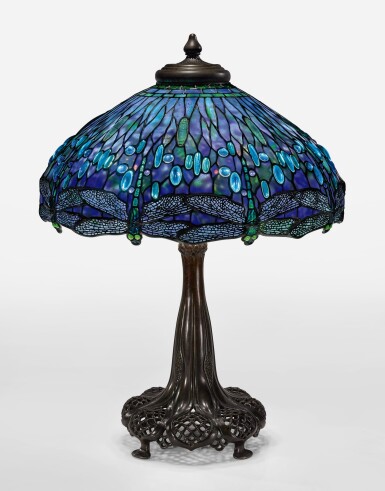Dreaming in Glass: Masterworks by Tiffany Studios
Dreaming in Glass: Masterworks by Tiffany Studios

Property from an Important American Collection
TIFFANY STUDIOS | AN IMPORTANT "DRAGONFLY" TABLE LAMP
Auction Closed
December 12, 11:00 PM GMT
Estimate
500,000 - 700,000 USD
Lot Details
Description
Property from an Important American Collection
TIFFANY STUDIOS
AN IMPORTANT "DRAGONFLY" TABLE LAMP
circa 1910
with a telescoping reticulated "Queen Anne's Lace" base
leaded glass, patinated bronze
shade impressed TIFFANY STUDIOS NEW YORK 1507-8
base impressed TIFFANY STUDIOS twice
29¼ in. (74.3 cm) high as shown
22 in. (55.9 cm) diameter of shade
Christie's New York, March 16, 1991, lot 199
Dr. Egon Neustadt, The Lamps of Tiffany, New York, 1970, pp. 171-178 (for the shade) and 179 (for a variant of the shade and the base)
Alastair Duncan, Tiffany At Auction, New York, 1981, p. 93, no. 248 (for the shade and base pairing); p. 102, no. 278 and p. 122, no. 330 (for the shade)
William Feldstein, Jr. and Alastair Duncan, The Lamps of Tiffany Studios, New York, 1983, pp. 103 and 169 (for the shade); p. 125 (for a variant of the shade)
Alastair Duncan, Fin de Siècle Masterpieces from the Silverman Collection, New York, 1989, p. 29 (for the shade)
Robert Koch, Louis C. Tiffany's Glass, Bronzes, Lamps: A Complete Collector's Guide, New York, 1989, p. 128 (for a variant of the shade and the base)
Takeo Horiuchi, ed., The World of Louis Comfort Tiffany: A Selection from the Anchorman Collection, Nagoya, Japan, 1994, p. 72 (for the shade)
Robert Koch, Louis C. Tiffany: The Collected Works of Robert Koch, Atglen, PA, 2001, p. 240 (for a variant of the shade and the base)
Alastair Duncan, Louis C. Tiffany: The Garden Museum Collection, Woodbridge, Suffolk, 2004, p. 305 (for the shade)
Martin Eidelberg, Alice Cooney Frelinghuysen, Nancy A. McClelland and Lars Rachen, The Lamps of Louis Comfort Tiffany, New York, 2005, pp. 34 and 196 (for the shade and base pairing); p. 197 (for the shade)
Marilyn A. Johnson, Louis Comfort Tiffany: Artist for the Ages, London, 2005, p. 161 (for the shade)
Alastair Duncan, Tiffany Lamps and Metalware, Woodbridge, Suffolk, 2007, p. 85, nos. 329-330 and p. 155, no. 643 (for the base); p. 156, no. 647 and p. 215, no. 847 (for the shade)
Martin Eidelberg, Nina Gray and Margaret K. Hofer, A New Light on Tiffany: Clara Driscoll and the Tiffany Girls, exh. cat., New York Historical Society, 2007, pp. 46 (for the base) and 62 (for the shade)
Margaret K. Hofer and Rebecca Klassen, The Lamps of Tiffany Studios: Nature Illuminated, New York, 2016, pp. 53 and 55 (for the shade)
Louis Tiffany was enamored by dragonflies and masterfully incorporated the insect into several of his decorative schemes, including enamels, mosaics and jewelry. He was not only mesmerized by the dazzling and shimmering iridescence of the dragonfly’s body but, as an avid and knowledgeable collector of Asian decorative arts, Tiffany was also likely aware of its symbolism in those cultures. To the Japanese, the dragonfly symbolized power and agility, while the Chinese associated it with prosperity, harmony and good fortune. It is therefore no surprise that Tiffany so effectively integrated the dragonfly into his leaded glass shades.
Clara Driscoll and Alice Gouvy are rightfully credited with developing the first "Dragonfly" lamp for the Tiffany Glass and Decorating Company in 1899. The model, however, would never have been produced had Louis Tiffany not overruled the firm’s accountants, who felt the shade was too impractical and expensive to produce. Tiffany’s judgement was justified when an early example was exhibited at the 1900 Paris Exposition and Driscoll was awarded a bronze medal and the company a gold medal for their work in electric lighting.
Tiffany produced the Dragonfly lamp shade in a variety of sizes and shapes, and it was probably the most successful model ever designed by the firm. The 22-inch version was perhaps the most popular shade the company ever manufactured and the example offered here is outstanding. The nine descending emerald-eyed dragonflies gradually transition from teal to green, their slightly overlapping filigreed wings in lighter shades of blue, violet and green. They are on an exceptionally painterly background that evokes the impression of the insects hovering in a clear sky at dusk, as the mottled periwinkle-blue opalescent glass is gradually tinged with lavender and darkens to a powdery green-streaked azure. It is beautifully enhanced with oval-shaped jewels of transparent teal and turquoise glass and circular ones of brilliant sapphire. The band of elongated jewels in the upper section of the shade are particularly interesting. Apparently made of the same teal glass as some of the smaller oblong jewels, these larger ones are plated on the reverse, an effect not usually seen on this model, imbuing them with a greenish hue.
The telescoping bronze base is an ideal companion to the shade. Described in Tiffany Studios’ 1906 price guide as “Library, standard, 6 lights, cast stem, large slide,” at $150 it was one of the most expensive table lamp bases produced by the company. Superbly cast and given a rich brown patina, the lower scalloped section, raised on four curved feet, gently mimics the shape of the shade while the openwork echoes the dragonflies’ filigreed wings. Furthermore, the stylized design in relief on the tapered column is reminiscent of the aquatic plants found in the insects’ natural habitat. This lamp, considered as a whole, is supremely artistic and a truly superb example of the model.
PAUL DOROS
